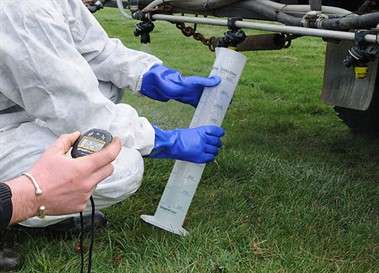Calibration
 The purpose of calibration is to apply the right amount of agrichemical. If you don't calibrate your equipment correctly, you may be applying too much or too little agrichemical which can lead to problems.
The purpose of calibration is to apply the right amount of agrichemical. If you don't calibrate your equipment correctly, you may be applying too much or too little agrichemical which can lead to problems.
If you use too little agrichemical:
- spraying may be ineffective ie pests or weeds may not die
- there is a risk of pests developing resistance to the agrichemicals you are using
- there will be increased risks and costs from failure to control the pest and you may have to reapply.
If you use too much agrichemical:
- it is a waste of the product
- there is increased cost
- the risk to you and the environment increases through runoff or drift
- there is increased risk of excess chemical residues in crops.
Approaches to calibration
- Volume-based spraying: wetting the target to the point of 'wet but no run-off' eg spot spraying with a knapsack
- Area-based spraying: applying an even amount of agrichemical across a target on a known area of land eg spraying a field
- Canopy-based spraying: application rates are adjusted to match the size and density of different target canopies eg increasing rates as trees develop from bare branches to full leaf.
Key factors
In spray application, the key elements determining the amount of agrichemical applied are:
- Flow rate - this is affected by the type and size of nozzle and pressure. Higher pressure increases flow rate so more spray mixture is applied. Different sized nozzles allow different amounts of spray mixture through - and a worn nozzle will allow more spray mixture through than a new nozzle.
- Speed - if the flow rate stays the same, going faster will apply less spray to each plant
- Swath width (width of application) - the wider the swath, the more area the spray mixture is being spread across. If you spray wider you have to increase the flow rate or decrease the speed to apply the same spray to each plant.
- Agrichemical concentration - the more concentrated the spray mix the more agrichemical being applied to the target plant. Concentration is largely determined by how much agrichemical concentrate you add to the tank. But inaccurate tank size can be another factor. Before you use a sprayer, you should check the accuracy of the volume marks on the side of the tank and is usually based on recommended label rates. Some tanks can be out by 10% e.g. a 15 litre backpack may only hold 13½ litres which will mean the spray mix is more concentrated than you have planned.
Steps in calibration
1. Planning
During planning all of the factors listed above are determined. Decisions are made on what chemical rates are required, what volume of water should be used and how the chemical is going to be delivered to the target. Choices need to be made on the nozzle type and size, droplet size, nozzle arrangement, travel speed, use of air, and air speed and profile. Calibration planning requires knowledge and experience of the agrichemicals, machinery and targets. It also involves some calculations.
- Flow rate - Check each nozzle's flow rate by measuring output in litres per minute.
- Speed - Tractor speed should be checked with the tank half full. Don't rely on the speedometer, measure the distance travelled and the time taken. If you change the tyres on your tractor, you will need to recheck the speed.
- Swath width - Measure in metres.
- Tank size - Inaccurate tank size will affect agrichemical concentration. Before you use a sprayer, you should check the accuracy of the volume marks on the side of the tank. Some tanks can be out by 10% eg a 15 litre backpack may only hold 13.5 litres which will mean the spray mix is more concentrated than you have planned.
2. Set up (if required)
When starting with a new sprayer or after changing nozzles, speed or pressure on an existing sprayer, you need to check the equipment to ensure it is operating in line with the figures used in your plan.